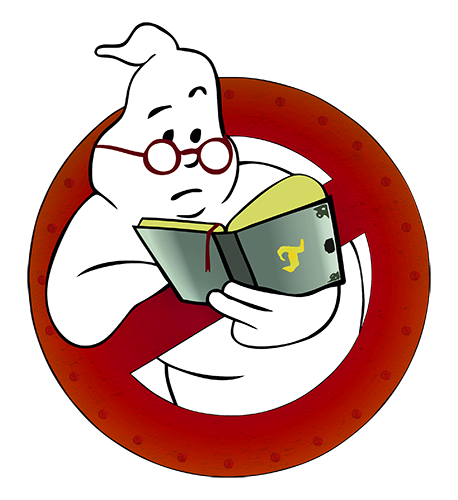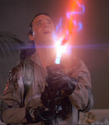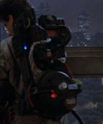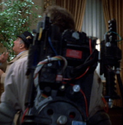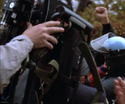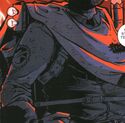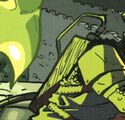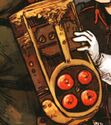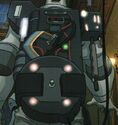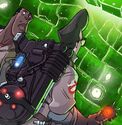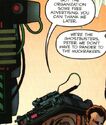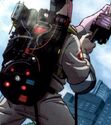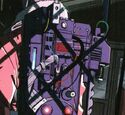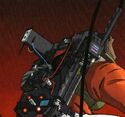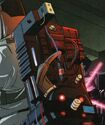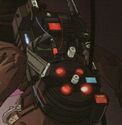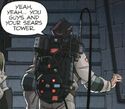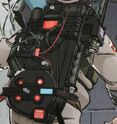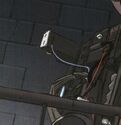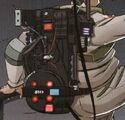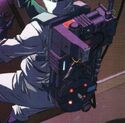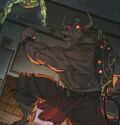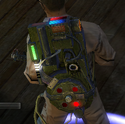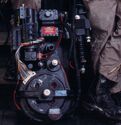"Hold your fire til we see a moment of weakness" Specifics: This is for Ghostbusters Get Real Miniseries
This article is about content that is either unreleased or only out recently that may be seen as a spoiler. This means that there is no spoiler rule in effect. Read the Spoiler Policy. |
- Dr. Venkman; Ghostbusters
The Proton Pack is the primary ghost capturing device used by the Ghostbusters.
History
Designed in 1984 by Egon Spengler and Ray Stantz, the Proton Pack counters the negative energy which ghosts are made of with a Proton Stream, a stream of positively charged ions which can harness a ghost. The Proton Stream is very dangerous and barely controllable. Egon has also mentioned that crossing Proton Streams will result in total protonic reversal causing all life as we know it to stop instantaneously and every molecule in a user's body to explode at the speed of light.
The Proton Packs are nuclear powered. The power cells of the Proton Pack have a half life of 5000 years. [1]
Function & Use
The Proton Packs are special, for they are the only piece of technology in the world that has the ability to strip electrons away from protons. It has a hand-held wand known as a "Neutrona Wand" (also called a Proton Gun or Particle Thrower) connected to a backpack-sized particle accelerator. The Proton Pack, also referred to as a charged particle accelerator, functions by using a miniature cyclotron to concentrate protons by channeling though a "positron collider" and then to the neutrona wand, emitting way-fire positronic ionized stream of proton energy that polarizes with the negatively charged ectoplasmic entities which held them in the stream while active even if they are out of phase with reality (basically, this description is technobabble). In practical terms, the Proton Gun fires a stream of energy that allows a wielder to snare a ghost. The stream reacts to ghost energy and uses that energy to hold the ghost in place so it can be positioned above a Trap for capture. Even if a ghost becomes invisible or intangible, their negative energy still exists, though it is slightly out of phase with normal reality. The positive stream neutralizes their invisibility or phaseshift ability, then forces them back in sync with our reality and holds them in place for capture.
Design
This section is to describe what makes of a Proton Pack.
Inconsistencies
Ray's Pack in the first movie on the first bust is falsely assumed to have yellow lights in the upper part near the blue "powercell lights" (Blue light bar that flashes going up). It is actually due to the black paint being worn off of the fiberglass shell, allowing the power cell lights to illuminate through.
Known Variants
- GB1 normal pack
- GB1 Hero pack (stunt packs made of foam rubber)
- GB2 Mid-grade pack (new packs)
- GB2 normal pack mkII (original pack with updates)
- GB2 Hero pack
- Universal Studios Florida pack
Secondary Canon History
Proton Pack in the Animated Series
The Proton Pack in the animated series was recolored a blue/dark blue, and the cyclotron has 3 lights instead of 4.
For even more information of the animated version of this character go to the animated article.
IDW Comics
When banished by Koza'Rai to the four corners of time and space, each of the original three Ghostbusters modified and constructed their own Proton Packs. Peter was modeled after the Old West-era, Ray's from Arthurian times, and Egon armed his own military force with Packs. In 1780, Leonardo da Vinci modified Janine Melnitz' Pack then made at least three more for the rookies she hired. Rachel Unglighter used magic on her own versions, dubbed "Mega-Packs," that she claimed were upgraded and there was no longer a danger in crossing the streams. It also had the ability to "freeze" ghosts with the flip of a blue switch.
Years later, before the Schenectady case, Egon removed the cooling covers from the Proton Packs. The removal made the packs lighter but apparently the covers presented something of a cancer risk. [2] When considering shooting the human host of the Hungry Manitou, Egon believed a weak spread would only cause short term memory loss and possible violent bowel evacuation. [3] After the Schenectady case, Egon modified the potency of the packs to compensate for the prolonged surge affecting the ambient psychokinetic energy. After the Ghostbusters were imprisoned in the Collectors' Limbo, they used Ray's Proton Pack to jury rig a controlled explosion and rip a hole in the interdimensional fabric just wide enough for them to slip through and return home despite the small chance the explosion could cause the dimension to fold over their own and destroy both places.
During the Chi-You incident, the Ghostbusters and Turtles had to split into two teams to deal with Chi-You and start building an Interspatial Teleportation Unit. Before one team set off for the Madison Square Garden, Ray Stantz gave his spare pack to Donatello. Before Michelangelo could finish asking for one, too, Leonardo shot down the request. When Chi-You was in possession of Winston, his Proton Pack was also transmogrified. The pack took on the appearance of a turtle shell.
Ghostbusters: Sanctum of Slime
Over the next decade, Egon and Ray continue to make upgrades to the Proton Packs. Egon's and Ray's studies on paranormal entities have revealed that Ectoplasm can be charged with different sub-atomic charges. The junior team are the first to use this new version of the Packs, complete with the Proton Beam, Fermion Shock, and Plasma Inductor options. Each option is designed to disperse an entity with a specific weakness to a certain energy frequency and thus, reduce the need for the Ghost Traps.
Trivia
- In the July 6, 1983 (and August 5) draft, Egon Spengler plugged the Proton Pack prototype into an AC outlet. The pack heated up to 550 degrees and the resulting surge melted the outlet then caused a downtown blackout. [4] [5]
- In the October 7, 1983 script, Winston and Egon charged the Proton Packs off the City Hall building's current as the team prepared to depart the loading dock. [6]
- The term "Proton Pack" was actually not used onscreen until halfway through the second film, when Egon says "before we go any further I think we should get our Proton Packs". However, the term was used in the script drafts of the first movie. [7] [8]
- Stephen Dane constructed prototypes made of balsawood and cardboard with major input from Ivan Reitman and Dan Aykroyd. Once the design was finalized, Chuck Gaspar went to work on the models to be used in the movie. [9]
- For the Proton Pack, Stephen Dane based his rough sketches on flamethrowers he recalled from military magazines. He bought a pack frame from California Surplus, on Santa Monica and Vine, and built a rough mock-up of the backpack flamethrower idea. Dane and Reitman talked and refined the design. The working design then went to the prop builders. Dane continued to guide the construction and bought some parts to be used in the early mock-up phase. [10]
- During filming of Ghostbusters, the operational Proton Pack models, with the batteries, weighed about 50 pounds. When the batteries were taken out, the packs were about 20 pounds lighter. [11]
- In the Ghostbusters II August 5, 1988 draft, Egon did not know how long the Proton Packs could last. [12]
- During filming of Ghostbusters II, a more lightweight model was used that weighed about 28 pounds but didn't light up much. [13]
- In Ghostbusters: The Video Game, crossing the streams only causes the Ghostbusters involved to be knocked down by the backlash and suffer a bit of damage. This is a safety feature introduced to the revised Proton pack, explicitly called "cross-stream governor" by Egon. The safety can be turned off, allowing the packs to cross the streams in case of emergency, [14] as is the case in the battle against Ivo Shandor.
- The pack also gets three upgrades/new attack modes during the course of the game (field tested by the player's character).
- From Issue #9 and on, Dan Schoening began to draw in an extra Hydrogen Gas Actuator to differentiate the Proton Packs in the ongoing comic book series from the ones in the movies. [15]
- Dan Schoening originally drew the Proton Pack as mix of packs done by fans but he currently draws them from memory. Any pack lights are Luis Delgado's ideas. [16]
- The Proton Pack's design served as the inspiration for the design of the Gluon Gun from Half-Life 1.
Also See
- Proton Pack - Ghostbusters: The Video Game (Realistic Versions)
- Proton Pack - Ghostbusters: The Video Game (Stylized Versions)
- Proton Pack - Ghostbusters: The Video Game (Stylized Portable Versions)
- Proton Pack - Animated Versions
- Particle Thrower - Animated Versions
Appearances
Primary Canon Appearances
Secondary Canon Appearances
- 88MPH Studios
- Ghost Busted (manga)
- Chapter 1
- Chapter 3
- Chapter 4
- Chapter 5
- Chapter 6
- IDW Comics
- "The Other Side 1"
- "The Other Side 2"
- "The Other Side 3"
- "The Other Side 4"
- "Displaced Aggression Issue 1"
- "Displaced Aggression Issue 2"
- "Displaced Aggression Issue 3"
- "Displaced Aggression Issue 4"
- "Past, Present, and Future"
- "Tainted Love"
- "What in Samhain Just Happened?"
- "Guess What's Coming to Dinner?
- "Ghostbusters: Infestation 1"
- "Ghostbusters: Infestation 2"
- Volume 1
- Ghostbusters Issue #1
- Ghostbusters Issue #2
- Ghostbusters Issue #3
- Ghostbusters Issue #4
- Ghostbusters Issue #5
- Ghostbusters Issue #6
- Ghostbusters Issue #7
- Ghostbusters Issue #8
- Ghostbusters Issue #9
- Ghostbusters Issue #10
- Ghostbusters Issue #11
- "Who Killed Laura Parr?" Part Three
- Ghostbusters Issue #12
- "Who Killed Laura Parr?" Part Four
- Ghostbusters Issue #13
- Ghostbusters Issue #14
- Ghostbusters Issue #15
- Ghostbusters Issue #16
- Volume 2
- Ghostbusters Issue #1
- Ghostbusters Issue #2
- Ghostbusters Issue #3
- Ghostbusters Issue #4
- Ghostbusters Issue #5
- Ghostbusters Issue #6
- Ghostbusters Issue #7
- Ghostbusters Issue #8
- Ghostbusters Issue #9
- Ghostbusters Issue #10
- Ghostbusters Issue #11
- Ghostbusters Issue #12
- Ghostbusters Issue #13
- Ghostbusters Issue #15
- Ghostbusters Issue #16
- Ghostbusters Issue #17
- Ghostbusters Issue #18
- Ghostbusters Issue #19
- Ghostbusters Issue #20
- Teenage Mutant Ninja Turtles Ghostbusters
- Ghostbusters Get Real
- Ghostbusters: Times Scare!
- The X-Files: Conspiracy: Ghostbusters
- Ghostbusters: Sanctum of Slime
References
- ↑ Egon Spengler (1999). Ghostbusters II - Chapter 12: Two in the Box (1989) (DVD ts. 34:10-34:13). Columbia Pictures. Egon says: "It should. The power cells have a half-life of 5,000 years."
- ↑ Egon Spengler (2012).IDW Comics- "Issue #5" (2012) (Comic p.17).
- ↑ Egon Spengler (2012).IDW Comics- "Issue #6" (2012) (Comic p.3).
- ↑ Shay, Don (November 1985). Making Ghostbusters, p. 68 annotation. New York Zoetrope, New York NY USA, ISBN 0918432685. Paragraph reads: "In the July and August drafts, Spengler conducts an early demonstration of the experimental ghostbusting equipment for his comrades at the firehall. Since the self-contained unit is still under development, the existing prototype is plugged into an AC outlet. An audible surge of power runs from the wall socket along the extension cord to the power pack on Spengler's back. The pack heats up to 550 degrees and kicks the electrical surge back down the wire to the wall outlet which melts. At once, all the lights in the room black out. Compounding the gag, the action then cuts to an exterior of the firehouse as all the lights in and on the building go out, as does the street lamp and the stoplight at the corner. Then the action cuts once again to a long shot of downtown office buildings as they all black out in rapid succession, leaving dark silhouettes against the night sky."
- ↑ Aykroyd, Dan & Ramis, Harold (1983). Ghostbusters (First Draft August 5, 1983) (Script p. 23). Paragraph reads: "An audible surge of power runs from the wall socket along the extension cord to the power pack on Spengler's back. The pack heats up to 550 degrees and kicks the electrical surge back down the wire to the wall outlet which melts. At once, all the lights in the room black out.""
- ↑ Third Draft, Revised 10/7/1983, p. 167 via Spook Central
- ↑ Third Draft, Revised 10/7/1983, p. 24 via Spook Central
- ↑ Aykroyd, Dan & Ramis, Harold (1983). Ghostbusters (First Draft August 5, 1983) (Script p. 22). Egon says: "This is the Proton Pack, Peter.""
- ↑ Shay, Don (November 1985). Making Ghostbusters, p. 69 annotation. New York Zoetrope, New York NY USA, ISBN 0918432685. Paragraph reads: "The proton packs and nutrona wands were constructed in balsawood and cardboard prototype form by Steven Dane -- with significant input from Ivan Reitman and Dan Aykroyd -- and then turned over to Chuck Gaspar for actual construction."
- ↑ "Beyond the Marquee: The Web-Series (Episode 70) – The GHOSTBUSTERS Ecto-1 Car and Designer Stephen Dane" 9/18/14
- ↑ Eisenberg, Adam (November 1989). Cinefex #40, p. 7. Cinefex, USA.
- ↑ Aykroyd, Dan & Ramis, Harold (1988). Ghostbusters II (August 5, 1988 Draft) (Script p. 39). Egon Spengler says: "We never tested to find out how long the fuel cells would last without recharging. We may have no power."
- ↑ Eisenberg, Adam (November 1989). Cinefex #40, p. 7. Cinefex, USA.
- ↑ GBTVGReferenceCrossingTheStreamsRV.jpg
- ↑ Dan Schoening post IDW Forums 6/4/12
- ↑ Dapperpomade Tweet 3/20/14
